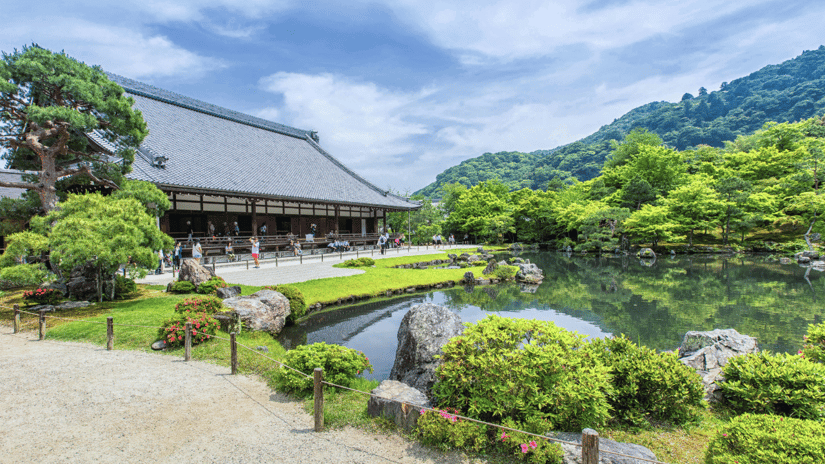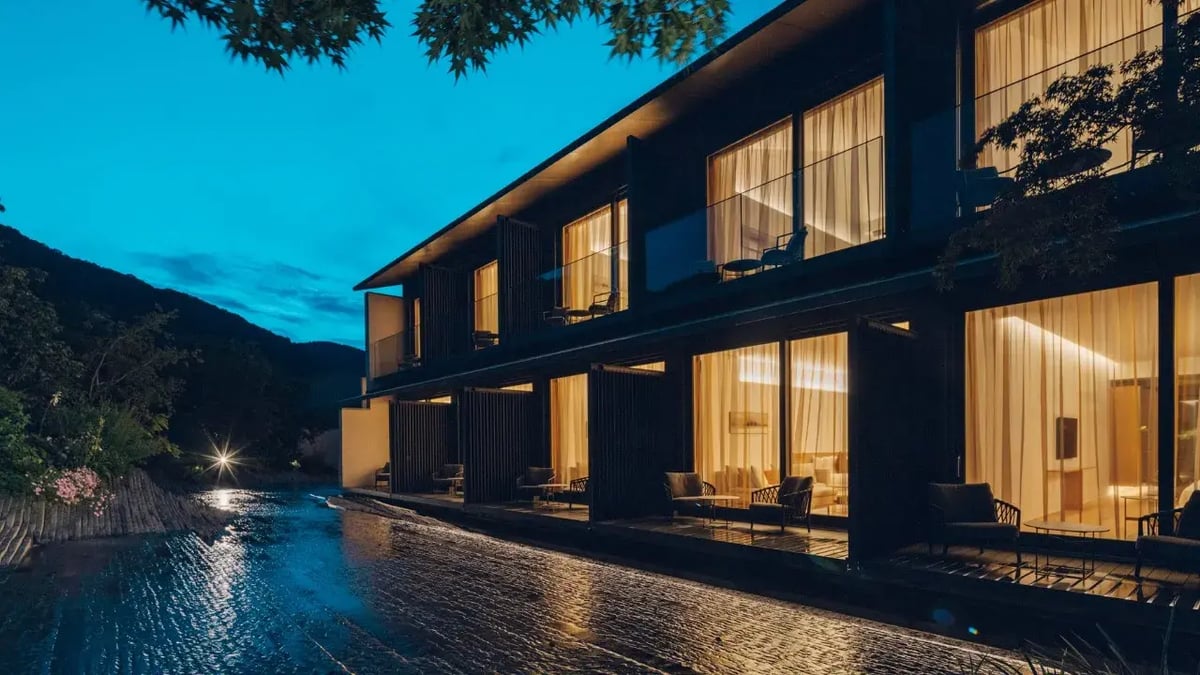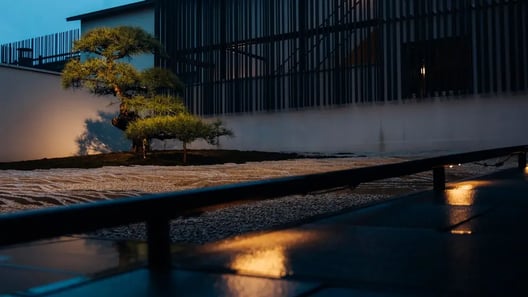🕓 2025/5/14
#寺
A Detailed Explanation of the History and Overview of Arashiyama Tenryu-ji Temple

Table of Contents
- Overview of Arashiyama Tenryu-ji Temple
- History of Arashiyama Tenryu-ji Temple
- Recommended Hotels in Arashiyama
- Highlights of Arashiyama Tenryu-ji Temple
Introduction
Tenryu-ji Temple, located in the beautiful surroundings of Kyoto's Arashiyama, is the head temple of the Tenryu-ji branch of Rinzai Zen Buddhism. This temple was founded in 1339 by Ashikaga Takauji to honor the memory of Emperor Go-Daigo.
In 1994, Tenryu-ji was registered as a UNESCO World Heritage Site as part of the "Historic Monuments of Ancient Kyoto," and its stunning Sogenchi Garden was the first in Japan to be designated as both a Special Historic Site and a Special Place of Scenic Beauty. This article provides a detailed overview of Tenryu-ji's history and highlights.
1. Overview of Arashiyama Tenryu-ji Temple

Tenryu-ji Temple, located in Kyoto's Arashiyama, is the head temple of the Tenryu-ji branch of Rinzai Zen Buddhism. It was established in 1339 by Ashikaga Takauji to honor Emperor Saga. The temple is particularly famous for its garden, known as the Sogenchi Garden. This garden was the first in Japan to be designated as both a Special Historic Site and a Special Place of Scenic Beauty, and it offers particularly stunning views during the autumn foliage season.
The temple was built to honor the spirit of Emperor Go-Daigo, and its name, "Tenryu" (Heavenly Dragon), is derived from a dream in which a dragon ascended to heaven following the emperor's death. Tenryu-ji holds the top rank among Kyoto's "Five Great Zen Temples" and has played a significant role in the development of Zen Buddhism in Japan.

Designated as a UNESCO World Heritage Site in 1994 under the "Historic Monuments of Ancient Kyoto," Tenryu-ji is renowned for its historical and cultural significance. The Sogenchi Garden, designed by Muso Soseki, features a stunning pond-centered stroll garden that harmoniously incorporates the natural landscape of Arashiyama and the surrounding scenery.

While the temple buildings have been rebuilt multiple times due to fires, the current structures mostly date back to the Meiji period (1868-1912). However, the garden remains in its original form from the 14th century, making it a highly valuable historical site. Visitors to Tenryu-ji can experience Zen teachings through meditation and practice, offering a unique opportunity to connect with the Zen spirit.

Access to Tenryu-ji is convenient, with a 16-minute train ride from Kyoto Station to JR Saga-Arashiyama Station, followed by a 13-minute walk. It is also close to Arashiyama Station, making it an easily accessible destination for tourists.
2. History of Arashiyama Tenryu-ji Temple
Tenryu-ji has experienced many significant events from its foundation to the present day. Below are some of the key events in chronological order.
1. Foundation and Background (1339)

Tenryu-ji was established in 1339 by Ashikaga Takauji. The temple was founded to honor the memory of Emperor Go-Daigo, and it was initially named "Ryūkō-ji" (Dragon Prosperity Temple). However, it was later renamed "Tenryu-ji" (Heavenly Dragon Temple) after Ashikaga Takauji's brother, Ashikaga Tadayoshi, had a dream in which a golden dragon ascended to heaven. The temple's construction was funded by profits from trade with China, with the "Tenryu-ji Ships" being part of this effort. The renowned Zen monk Muso Soseki was appointed as the temple's first chief abbot.
2. Development and Influence (14th Century)
Tenryu-ji became a significant center of Zen Buddhism and was elevated to the highest rank among Kyoto's "Five Great Zen Temples" in 1386. During this period, Muso Soseki designed the Sogenchi Garden, which was later designated as Japan's first "Special Place of Scenic Beauty." The garden's beauty is preserved to this day. Tenryu-ji flourished as a cultural center and had a profound influence on Zen culture in Kyoto.
3. Fires and Rebuilding (15th–19th Century)
Tenryu-ji suffered numerous fires throughout its history. The first major fire occurred in 1358, and subsequent fires during events like the Onin War (1467–1477) and another fire in the early 18th century caused significant damage. The Onin War, in particular, inflicted heavy damage on many temples in Kyoto, including Tenryu-ji.
In 1590, with the support of Toyotomi Hideyoshi, reconstruction efforts were undertaken, but fires continued to plague the temple. In 1815, nearly all of the buildings were destroyed by fire, and another fire occurred in 1864. The majority of the current buildings were reconstructed after these fires.
4. Modern Preservation Efforts (20th Century–Present)
In 1994, Tenryu-ji was designated as a UNESCO World Heritage Site under the "Historic Monuments of Ancient Kyoto," solidifying its status as an internationally recognized cultural treasure. Today, many cultural assets and the gardens are preserved, with the Sogenchi Garden being particularly celebrated and designated as a Special Place of Scenic Beauty.
The garden remains in its original form from the time of its creation, reflecting the vision of Muso Soseki. Tenryu-ji continues to serve as a place for Zen practice and meditation, attracting many visitors and practitioners from around the world.
3. Recommended Hotels in Arashiyama
MUNI KYOTO by 温故知新 : A Modern Kyoto Small Luxury Hotel







Located quietly beside the iconic Togetsukyo Bridge in Arashiyama, MUNI KYOTO by 温故知新 is a refined luxury hotel that combines Japan’s traditional aesthetics with modern design. This harmonious blend offers a unique and unforgettable stay experience, deeply connected to the rich natural beauty of Arashiyama.
1. A Unique and Picturesque Setting

Situated in a prime location directly in front of Togetsukyo Bridge, a symbol of Arashiyama, the hotel provides breathtaking views of the seasonal natural beauty surrounding the area.
Simply gazing out from your window immerses you in nature’s artwork. Rooms with terraces allow guests to enjoy the serene silence of the morning or the magical hues of the evening, accompanied by the gentle murmur of the Katsura River and the whispering winds—moments that leave a lasting impression of tranquility.
2. Sophisticated Guest Rooms

The hotel features 21 rooms, each designed to harmonize with the grandeur of Arashiyama’s natural landscape. The decor emphasizes comfort and the beauty of “space and balance,” blending Eastern and Western influences and seamlessly fusing tradition with modernity. The use of natural materials and minimalist elegance creates a warm and inviting ambiance.
All rooms are equipped with large windows or balconies, offering sweeping views of Arashiyama’s natural beauty and the hotel’s stunning gardens. The soothing sound of the river enhances the sense of openness and privacy, creating a luxurious and peaceful retreat.
3. Exceptional French Cuisine
 🄫Jordan SAPALLY
🄫Jordan SAPALLY
The hotel features two French restaurants curated by world-renowned chef Alain Ducasse, offering guests an extraordinary culinary experience.
1. MUNI ALAIN DUCASSE

At "MUNI ALAIN DUCASSE," a Michelin one-star restaurant, you can enjoy exquisite French cuisine that showcases the seasonal ingredients of Kyoto during dinner. The course menus incorporate locally sourced vegetables and fresh seafood from the Sea of Japan, with each dish presented like a refined work of art.
2. MUNI LA TERRASSE
 🄫Jordan SAPALLY
🄫Jordan SAPALLY
"MUNI LA TERRASSE" is a casual restaurant located in an ideal spot overlooking the scenic Katsura River, perfect for various occasions from breakfast to lunch and afternoon tea. The breakfast menu features healthy and flavorful dishes made with fresh, locally sourced ingredients, while the freshly baked croissants and brioche are truly exceptional. During lunchtime, guests can enjoy light dishes and seasonal specialties, making it an excellent place to take a break in between sightseeing.
4. Thoughtfully Designed Facilities

The hotel’s facilities are meticulously crafted to provide a truly special stay for each guest.
The MUNI SPA offers treatments inspired by the blessings of Kyoto’s natural surroundings. Using local ingredients such as yuzu, Kitayama cedar, and tea seed oil, the custom aromatherapy oils are designed to balance the mind and body, delivering a deep sense of relaxation. Guests can enjoy private treatment rooms for a personalized and indulgent spa experience.
5. A Variety of Unique Experiences

MUNI KYOTO offers a range of unique programs designed to create unforgettable memories while immersing guests in Kyoto’s traditional culture and natural beauty. These programs are developed in collaboration with local businesses and artisans, ensuring authentic, community-based experiences.
1. Aerial Tours
Enjoy a helicopter flight offering stunning aerial views of landmarks such as Arashiyama, Togetsukyo Bridge, and Kinkaku-ji. The experience is particularly magical at sunset when the golden hues of the sun bathe Kyoto’s cityscape in a warm glow.
2. Japanese Sweets and Matcha Experience
Guests can learn the art of making traditional Japanese sweets from skilled artisans, followed by enjoying their creations paired with matcha. This popular program offers a deep dive into Kyoto’s cultural and aesthetic heritage.
3. Other Kyoto Experiences
Additional activities include ikebana (flower arrangement) workshops and exclusive early morning visits to the UNESCO World Heritage Site Tenryu-ji Temple, providing opportunities to explore Kyoto’s rich cultural traditions.
■ Access Information for MUNI KYOTO by 温故知新
- Official website: https://muni.by-onko-chishin.com/en/
- Access: A 12-minute walk from JR Sagano Line (Sanin Line) Saga-Arashiyama Station
- Address: 3 Saganomiyanomotocho, Ukyo Ward, Kyoto, Japan
- Google Maps: https://maps.app.goo.gl/BsQM93Fm5qvQCA9W9
4. Must-Visit Attractions in Tenryu-ji Temple
Tenryu-ji Temple, an important Zen temple located in Kyoto's Arashiyama district, offers numerous attractions. Below are some of the key highlights worth noting.
■ Sogenchi Garden
-Jul-27-2024-07-40-34-7561-AM.png?width=524&height=295&name=%E5%BC%81%E5%A4%A9%E5%A0%82%20(2)-Jul-27-2024-07-40-34-7561-AM.png)
Sogenchi Garden is one of Tenryu-ji's main attractions, boasting over 700 years of history. Designed by the renowned Zen monk Muso Soseki, this garden is a classic example of a strolling pond garden, where visitors can enjoy various views of the garden's beauty while walking around the pond. At the center of the garden is a large pond surrounded by strategically placed stones and pine trees. The garden incorporates the scenic backdrop of Arashiyama, offering stunning views that change with the seasons.
The garden is recognized as Japan's first "Special Place of Scenic Beauty," highlighting its aesthetic and historical value. It is particularly admired during the autumn foliage and cherry blossom season in spring, offering visitors a chance to experience the natural beauty throughout the year. The garden is not only a visual delight but also serves as a place of tranquility and harmony, reflecting the teachings of Zen.
■ Unryu-zu (Cloud Dragon Painting)

Unryu-zu is a large painting of a dragon on the ceiling of the Hatto (Dharma Hall), known for appearing to gaze at viewers from any angle. Painted by Kayama Matazo in 1997 to commemorate the 650th anniversary of Tenryu-ji's founder Muso Soseki, this artwork spans a diameter of 9 meters and leaves a profound impression on visitors.
The painting is displayed to the public on weekends and special holidays, allowing visitors to experience its impressive scale up close. The Hatto, where Unryu-zu is housed, also serves as a significant space for conveying Zen teachings, hosting meditation sessions and other spiritual practices.
■ Shoin and Kuri

The Shoin (study hall) and Kuri (kitchen) are key buildings within Tenryu-ji. The Shoin, divided into the "Great Shoin" and "Small Shoin," has historically served as the living quarters and study area for monks. The Great Shoin, completed in 1899, is used for ceremonies and large gatherings, featuring a spacious veranda facing the inner gate and windows overlooking the Sogenchi Garden. The interior follows traditional Shoin architecture, with six sections centered around a central Buddha statue.

The Kuri serves as the temple's kitchen and plays a vital role in preparing meals and managing the temple's economic activities. Inside the Kuri, there is a painting known as "Daruma-zu," depicting the founder of Zen Buddhism, Bodhidharma. The Kuri is also open to visitors, offering a valuable insight into Zen teachings and the temple's daily life.
■ Annual Events at Tenryu-ji

Tenryu-ji hosts a variety of Buddhist events throughout the year, each with its unique significance and history. The "New Year's Tea Ceremony" draws many visitors during the New Year, praying for peace and prosperity in the coming year. On February 3, the "Setsubun Festival" features a bean-throwing ceremony to ward off evil spirits. The "Nehan-e" on March 15 commemorates the Buddha's passing, reaffirming his teachings.
The "Hanamatsuri" on April 8 celebrates the Buddha's birthday with a ceremony involving pouring sweet tea over a flower-adorned altar. The "Ullambana Festival" in August includes a lantern-floating ceremony for ancestral spirits, honoring the deceased. The "Daruma Memorial" in October commemorates Bodhidharma, reinforcing his teachings and spirit. Finally, the "Jodo-e" on December 8 marks the Buddha's enlightenment, emphasizing the importance of the path to enlightenment.
In Conclusion
Tenryu-ji is a crucial temple in Japan, known for its historical background, beautiful gardens, and rich cultural heritage. The stunning Sogenchi Garden, Unryu-zu, and the Shoin and Kuri buildings offer visitors deep impressions. They convey the temple's rich history and tradition.
When visiting Kyoto, be sure to explore Tenryu-ji and experience its abundant history and culture.


